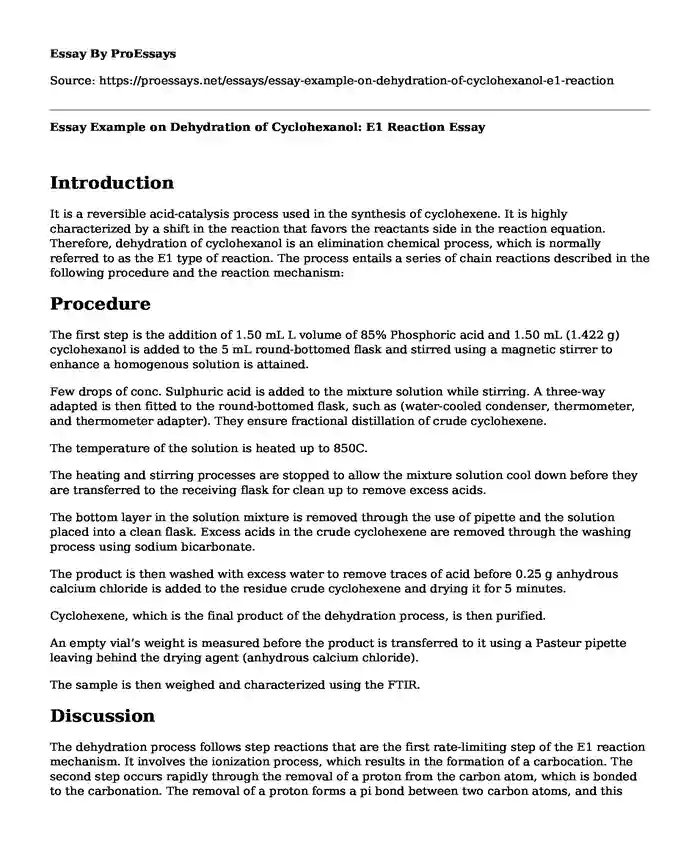Introduction
It is a reversible acid-catalysis process used in the synthesis of cyclohexene. It is highly characterized by a shift in the reaction that favors the reactants side in the reaction equation. Therefore, dehydration of cyclohexanol is an elimination chemical process, which is normally referred to as the E1 type of reaction. The process entails a series of chain reactions described in the following procedure and the reaction mechanism:
Procedure
The first step is the addition of 1.50 mL L volume of 85% Phosphoric acid and 1.50 mL (1.422 g) cyclohexanol is added to the 5 mL round-bottomed flask and stirred using a magnetic stirrer to enhance a homogenous solution is attained.
Few drops of conc. Sulphuric acid is added to the mixture solution while stirring. A three-way adapted is then fitted to the round-bottomed flask, such as (water-cooled condenser, thermometer, and thermometer adapter). They ensure fractional distillation of crude cyclohexene.
The temperature of the solution is heated up to 850C.
The heating and stirring processes are stopped to allow the mixture solution cool down before they are transferred to the receiving flask for clean up to remove excess acids.
The bottom layer in the solution mixture is removed through the use of pipette and the solution placed into a clean flask. Excess acids in the crude cyclohexene are removed through the washing process using sodium bicarbonate.
The product is then washed with excess water to remove traces of acid before 0.25 g anhydrous calcium chloride is added to the residue crude cyclohexene and drying it for 5 minutes.
Cyclohexene, which is the final product of the dehydration process, is then purified.
An empty vial’s weight is measured before the product is transferred to it using a Pasteur pipette leaving behind the drying agent (anhydrous calcium chloride).
The sample is then weighed and characterized using the FTIR.
Discussion
The dehydration process follows step reactions that are the first rate-limiting step of the E1 reaction mechanism. It involves the ionization process, which results in the formation of a carbocation. The second step occurs rapidly through the removal of a proton from the carbon atom, which is bonded to the carbonation. The removal of a proton forms a pi bond between two carbon atoms, and this produces an alkene (Yu et al. 318). The process uses sodium bicarbonate as a displacement agent that removed the proton in the E1 reaction. Therefore the phosphoric (v) acid used in the reaction process acts as the dehydration agent because it protonates the OH group and makes it into a stable leaving group as water.
The catalyst in the reaction increases the rate of reaction towards the attainment of the reaction products. The measurement of the product formed in the reaction is obtained through the subtraction of the variable used.
Product = weight of vial with content – the weight of the empty vial
Percentage yield %=100 % weight of vial with content – the weight of empty vial weight of the empty vial
Conclusion
Dehydration of cyclohexanol is a step reaction that results in the formation of cyclohexene and water as the final products. The reaction process involves the removal of water from the cyclohexanol to form cyclohexene.
Work Cited
Yu, Jieping, et al. "Thermally coupled reactive distillation system for the separations of cyclohexene/cyclohexane mixtures." Industrial & Engineering Chemistry Research 55.1 (2016): 311-322.
Cite this page
Essay Example on Dehydration of Cyclohexanol: E1 Reaction. (2023, Sep 10). Retrieved from https://proessays.net/essays/essay-example-on-dehydration-of-cyclohexanol-e1-reaction
If you are the original author of this essay and no longer wish to have it published on the ProEssays website, please click below to request its removal:
- Problem-solving in Maths and Everyday Life
- Questions and Answers on Hydrogen in Metals I-Basic Properties
- National Geographic: The Photographic Vision Essay Example
- Linear, Quadratic and Exponential Equations and Their Uses Essay Example
- Life Beyond Earth Essay Example
- Paper Example: Exploring Strain Tensors in 2D and 3D Geometry
- Essay Sample on Unstable vs Stable Molecules: Chemical Bonds & Valence







